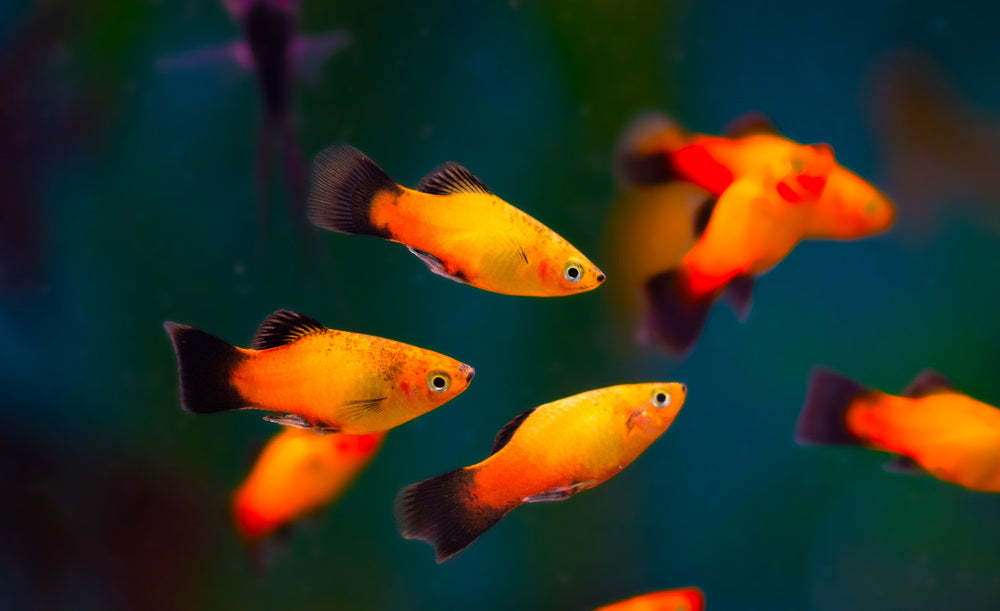How Many Platies Should Be Kept Together

Introduction
Platies are great for aquariums. They come from Central America and have pretty colors. They are peaceful and easy to take care of. But, it’s important to know how many to keep together to make them happy.
The number of platies to keep in a single tank isn’t a one-size-fits-all answer. Several factors, including the size of the aquarium fish, water quality, and the gender mix of your platies, play a crucial role in determining the ideal population. Understanding these factors is essential for maintaining a healthy and harmonious environment for your platies.
In this guide, we will delve into the considerations and principles that should guide your decisions on the number of platies to keep together. We’ll explore the importance of tank size and how it impacts the comfort and well-being of your fish. We’ll also discuss the dynamics of male and female platies, including their reproductive tendencies and the implications for population control. By the end of this exploration, you’ll be better equipped to strike the right balance between aesthetic appeal and the welfare of your platy community.

Do platys need to be in groups?
Broad-bodied fish are easy to procreate if their aquarium has enough plants for privacy. Platies flourish in smaller groups of five fish.
While platies don’t need vast schools like other species, they do thrive from small groupings. These three- to five-person groups give them security and camaraderie. Platies can grow agitated and lonely when kept alone, which can harm their health.
Group platies swim and display their vivid colors more naturally. The platy hierarchy’s dynamic development is remarkable.
Platies like being in groups, but you need to think about your tank’s size and if you can take care of the group.
How many fish can platy fish have?
Platies can have from 20–50 fry (baby fish) at once, as often as once a month. They may also eat their own young.
Depending on age, size, and health, a female platy can produce 20–80 fry (baby platies) in a pregnancy. Given its reproductive capacity, aquarium population growth must be understood and managed.
How many platy fish can you keep depends on your tank size and aquarist goals. To regulate and sustain the population, separate adult males and females or give enough of hiding places for fry to avoid predation. You may also let platys breed freely in a larger tank with enough space and money.
Overcrowding your tank can cause territorial disputes, poor water quality, and stressed fish. Plate fish can have a variable amount of fish depending on your goals, tank size, and population management.
How many platys are born at once?
Once the mother gives birth, you can expect to have 20-40 new fry on average. Sometimes, this number can climb as high as 80.
Platys, also known as platy fish (Xiphophorus maculatus), are prolific breeders, and the number of fry (baby platys) born at once can vary significantly. A single female platy can produce anywhere from 20 to 80 fry or even more in a single pregnancy. The exact number of fry largely depends on several factors, including the age and size of the female, her health, and the environmental conditions in the aquarium.
Younger and smaller female platys typically produce fewer fry, while larger, more mature females can have larger broods. Additionally, well-maintained and stress-free aquariums with stable water conditions tend to promote higher reproductive success. It’s important to note that platys are livebearers, which means they give birth to fully-formed fry rather than laying eggs. This livebearing nature allows the fry to have a higher chance of survival compared to egg-laying species.
As an aquarist, understanding the prolific breeding nature of platy fish is essential for managing their population in your aquarium. You can control and manage the number of fry by separating adult males and females, providing hiding places for fry, or controlling breeding conditions. This way, you can maintain a healthy and sustainable platy population in your tank while preventing overcrowding.
Can 2 platy fish live together?
How many platies should be kept together? A group of three to six platies is a good starting point. As with most livebearers, the males constantly want to mate, so try to keep at least two females for every one male to give the girls a break.
Platy fish, also known as Xiphophorus maculatus, are peaceful and colorful freshwater fish that are popular choices for aquarium enthusiasts. When it comes to keeping platy fish together in the same tank, the answer is generally yes, they can coexist peacefully. In fact, platies are known for their social nature, and they often thrive when kept in small groups of two or more.
However, there are a few considerations to keep in mind when housing multiple platy fish together. First, it’s important to ensure that the tank is appropriately sized to accommodate the number of platies you plan to keep.
Second, it’s essential to provide adequate hiding spots and plants in the aquarium to offer them places to explore and seek refuge if needed. This helps reduce stress and territorial conflicts among the fish.
Lastly, maintaining good water quality and monitoring for any signs of aggression or stress among the platy fish is crucial. Overall, with proper care and attention to their environment, platy fish can indeed live harmoniously together in a well-maintained aquarium.
Are platys aggressive with each other?
Platys have a reputation for being amiable fish that get along with each other. Only when you introduce two males to a tank would you normally see any sort of aggression.
Small freshwater fish are more likely to socialize and coexist peacefully with each other and other non-aggressive fish.
Remember that platys are normally gentle, although personalities vary. Plate fish may occasionally nip or show modest territorial behavior if they are overcrowded, lack hiding spaces, or are stressed by tank conditions. Providing enough aquarium space, plants, and decorations to form territories and hiding spots can resolve these confrontations.
Maintaining water quality, monitoring fish behavior, and separating aggressive fish can help create a happy platy colony. Platies are not aggressive, however territorial behavior may be regulated with careful tank management.
Can goldfish and platys live together?
All fish make ammonia, but goldfish make a lot of it, which can be harmful to other small fish and even kill them.
Although goldfish and platies can live in the same aquarium, it can be hard to keep them together because they like different types of water. Goldfish like cold water, but platies like warmer water because they are tropical fish.
Additionally, goldfish are known to produce more waste than many other fish, which might lead to poorer water quality if not adequately managed. This can be a concern for platies that prefer better water conditions.
Moreover, goldfish tend to be larger and can sometimes mistake smaller fish like platies as food, especially if they can fit in their mouths. There’s a risk of the goldfish preying on the smaller platies.
Separating these species into different tanks with suitable conditions tailored to their individual requirements is typically the best approach for their health and well-being.
What are the benefits of keeping multiple platies together?
Keeping multiple platies together in a community or group can offer several benefits for both the fish and the aquarist:
Social Interaction: Platies are social by nature, and when kept in groups, they engage in various social behaviors, such as swimming together, playing, and even displaying their vibrant colors. This can create an aesthetically pleasing and dynamic aquarium.
Reduced Stress: Being in the company of their kind reduces stress for platies. They feel safer and more secure in a group, which can lead to healthier and happier fish. This is especially important for their overall well-being.
Natural Behaviors: In a group, platies exhibit more natural behaviors, such as exploring their environment and showcasing their courtship and mating rituals. Observing these behaviors can be fascinating and educational for aquarium enthusiasts.
Hierarchy and Balance: Platies in a group often establish a hierarchy, which can help maintain order and reduce aggression. In a balanced group with the right gender ratio, males are less likely to harass individual females excessively.
Breeding Opportunities: If you’re interested in breeding platies, keeping multiple of them together provides the opportunity for successful reproduction. However, it’s essential to manage the population to prevent overcrowding.
Community Dynamics: When kept with other compatible fish species, platies can contribute to the overall health and dynamics of a diverse aquarium community. They are generally peaceful and get along with a variety of tankmates.
Keeping multiple platies together not only enhances their well-being but also offers an enriching experience for aquarists by allowing them to observe fascinating natural behaviors and interactions in a vibrant and dynamic aquatic environment.
Is there a maximum number of platies per tank?
The number of platies in a tank depends on its size, water quality, and filtration system. There is no set limit to how many can be kept. Platies are small, peaceful freshwater fish, and they can thrive in various tank sizes, from small setups to larger aquariums.
In general, a good rule of thumb is to provide at least 5 to 10 gallons of water for each platy. This means a 20-gallon tank could comfortably house 2 to 4 platies. However, a larger tank is always better as it provides more swimming space and helps maintain stable water conditions.
Water quality is crucial for platies, so ensuring proper filtration, regular water changes, and maintaining appropriate temperature and pH levels is essential. Overcrowding can lead to stress, aggressive behavior, and compromised water quality, which can be detrimental to their health.
Monitoring water parameters and observing your fish’s behavior can help you determine if the population in your tank is suitable or if adjustments are needed.

Conclusion
Aquarium keeping involves deciding how many platies can be kept together. It’s a complex task. As we’ve explored, several critical factors come into play, and understanding these factors is paramount to ensuring the well-being and vitality of your platy community.
The size of your aquarium is of utmost importance. A larger tank provides more space for platies to swim, reduces territorial disputes, and maintains water quality, leading to a happier and healthier group of fish. The ideal ratio of males to females should also be carefully considered to prevent overcrowding and control breeding.
Balancing aesthetics with the welfare of your platies is the key to a successful platy community. A crowded tank may be visually appealing, but it can result in stressed and unhappy fish. On the other hand, an underpopulated tank may lead to loneliness and boredom for your platies.
The ideal number of platies to keep together depends on tank size, maintenance, and personal preference. This guide will help you create a beautiful aquarium while keeping your platy friends healthy and comfortable. So whether you’re a beginner or an experienced aquarist, understanding platy population management will help you create a healthy and harmonious aquarium.



